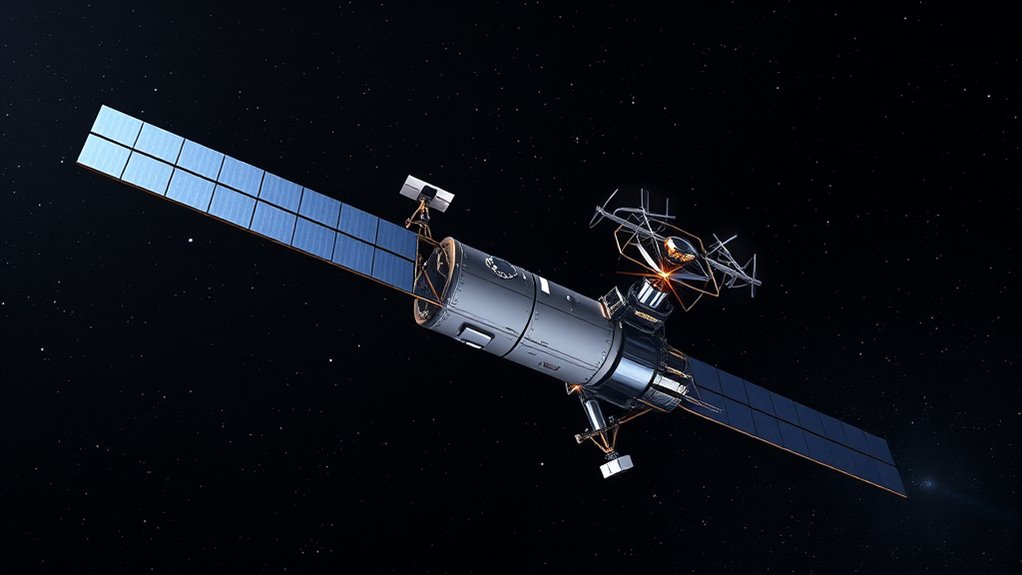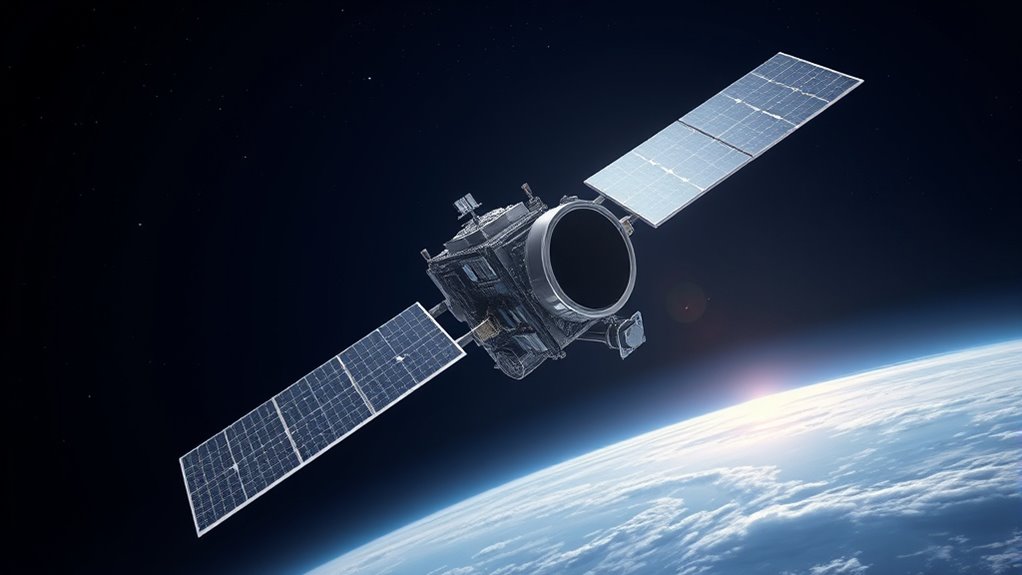Hybrid satellites combine optical and RF communication systems to provide high-speed data transfer, extensive coverage, and flexible performance for various space missions. They seamlessly manage data exchange across different channels, ensuring efficiency, security, and adaptability in changing conditions. By balancing both technologies, they optimize system reliability and bandwidth. As you explore further, you’ll discover how these innovations are shaping the future of space communication and satellite technology.
Key Takeaways
- Hybrid satellites integrate optical and RF systems to enhance data transfer capabilities and mission versatility.
- Communication protocols manage seamless data exchange, error correction, and synchronization across different channels.
- The integration process involves designing interfaces and control algorithms for dynamic link management.
- Balancing optical and RF systems requires protocols that adapt to changing conditions and prevent conflicts.
- These satellites enable higher bandwidth, improved reliability, and expanded coverage for diverse applications.

Have you ever wondered how modern satellites combine the best of different technologies? It’s all about hybrid satellites, which integrate optical and RF communication systems to maximize performance and versatility. This integration isn’t accidental; it requires meticulous satellite integration, where engineers carefully design and connect different subsystems to work seamlessly. By blending optical and radio frequency (RF) links, these satellites can adapt to a broad range of mission needs, from high-bandwidth data transfer to reliable global coverage. The key to making this work lies in robust communication protocols that govern how these diverse systems exchange data efficiently and securely.
In a hybrid satellite, communication protocols serve as the rules and standards that enable different subsystems to interact smoothly. When combining optical and RF communications, these protocols must guarantee compatibility across different signal types, frequencies, and data formats. They handle error correction, data prioritization, and synchronization, making sure that information flows without delays or misinterpretations. For instance, optical links can deliver high-capacity, low-latency data streams over short distances or in high-density environments, while RF links offer broader coverage and resilience against atmospheric interference. The protocols coordinate when and how each type of communication is used, optimizing the satellite’s overall performance.
Satellite integration plays a fundamental role here. It involves more than just physically connecting optical and RF modules; it requires designing the entire system architecture to support dynamic switching and data sharing. Engineers develop interfaces that translate signals between the two technologies, ensuring the data remains intact and intelligible. They also implement control algorithms that decide whether a particular communication link should be active based on current conditions, such as weather or movement. This integration allows hybrid satellites to operate efficiently in various scenarios, whether they’re transmitting high-resolution images via optical links or maintaining constant contact with ground stations through RF. Additionally, effective management of these systems is crucial to prevent conflicts and optimize resource allocation, further enhancing operational efficiency.
The challenge lies in balancing these different systems so they complement each other rather than conflict. This is achieved through carefully crafted communication protocols, which dictate how data is packetized, transmitted, and acknowledged across the satellite’s subsystems. These protocols must be adaptable, capable of handling the rapid shifts between optical and RF channels as needed. When everything is aligned—from hardware design to data management and protocol implementation—the satellite becomes a flexible, powerful tool for modern communications, Earth observation, and space exploration.
Ultimately, the success of hybrid satellites depends on how well their communication protocols facilitate smooth integration between optical and RF technologies. This synergy allows for increased bandwidth, enhanced reliability, and expanded coverage, making hybrid satellites a essential component of the future space infrastructure.
Frequently Asked Questions
How Do Hybrid Satellites Manage Data Security Across Different Communication Types?
You guarantee data security by implementing robust encryption protocols and strict access controls. These measures protect information during transmission, whether via optical or RF communication. You also monitor and update security systems regularly to counter evolving threats. By managing encryption keys carefully and restricting access to authorized personnel, you maintain the integrity and confidentiality of data across different communication types, ensuring seamless and secure hybrid satellite operations.
What Are the Main Challenges in Integrating Optical and RF Systems?
You face several challenges when integrating optical and RF systems. Interference mitigation becomes complex, as each system has unique vulnerabilities and noise sources. Ensuring system interoperability is also tricky, requiring seamless communication between different hardware and protocols. You must develop robust algorithms and standards that allow these technologies to work together efficiently, overcoming potential conflicts and maintaining reliable, secure data transmission across diverse communication environments.
How Cost-Effective Are Hybrid Satellite Networks Compared to Traditional Systems?
When evaluating cost-effectiveness, you should conduct a thorough cost analysis and consider your budget considerations. Hybrid satellite networks can be more cost-effective over time because they optimize communication channels, reducing operational expenses. Although initial investments might be higher, the improved efficiency and flexibility often lead to savings. Overall, they offer a strategic advantage by balancing performance and costs, making them a smart choice compared to traditional systems.
What Advancements Are Needed to Enhance Hybrid Satellite Communication Reliability?
Think of your satellite system as a finely tuned orchestra; its reliability depends on seamless harmony. To enhance this, you need advancements in interference mitigation and power optimization. Reducing signal disruptions ensures clearer communication, while smarter power use extends satellite lifespan and performance. These improvements act like the conductor’s baton, guiding your hybrid network to operate smoothly, even amid the chaos of space, making your communication more dependable and resilient.
How Do Hybrid Satellites Impact Global Connectivity in Remote Areas?
You can see that hybrid satellites greatly improve remote area connectivity by combining optical and RF links, ensuring reliable communication where traditional networks struggle. They expand global coverage, making it possible for people in isolated regions to access the internet, emergency services, and other essential communications. This integration helps bridge the digital divide, providing underserved communities with better opportunities and fostering inclusive global connectivity.
Conclusion
You now see how hybrid satellites combine optical and RF communication to enhance global connectivity. Notably, this technology can increase data transmission speeds by up to 10 times compared to traditional systems. By integrating these methods, you can expect more reliable, faster, and versatile satellite networks. As the demand for seamless communication grows, hybrid satellites will play a vital role in shaping the future of global connectivity, ensuring you stay connected wherever you are.









